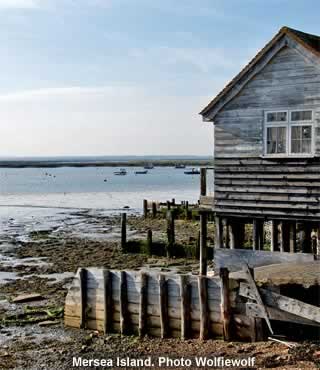Mersea Island |
|
 |
|||
A small island tucked away in a little nook on the Essex coast famous for its Oysters |
||
Mersea is a small island, just 18 square kilometres, tucked away in a little nook on the Essex coast. But as tucked away as it is, Mersea Island was nevertheless discovered and inhabited from very early on in British history, well before the Romans ever set eyes on the place. |
||
One of the best pieces of evidence is an ancient burial mound, which was discovered in 1912. Inside, they found a small glass urn, holding the ashes of a cremated child. The urn is now on display at the Castle Museum in Colchester, but the burial mound is sometimes opened to the public, so you can see where it was found. Elsewhere on Mersea, archaeologists have also found animal bones that date even further back in time. These show that the island was once home to elephants, rhinos, and hippos! Unfortunately, seeing one now would be, to put it mildly, very unusual. |
||
Today, the island is more concerned with creatures like fish, and particularly, oysters. There are oyster farms here that supply to countries all around the world. Every year the Mayor of Colchester visits the island to taste and celebrate the first oysters of the season. |
||
The local businesses and traditions are explained in more detail at the Mersea Island Museum. These are mostly based around the water and, as well as oystering, include fishing and boat building. The museum also contains a reconstruction of a fisherman's cottage from the Victorian era. Other exhibits look at the island's local, natural, and geological history. |
||
The museum is located in West Mersea, which is the only town on the island. It's where you'll find most facilities and amenities. The town is notable for its beach, which is kept safe and clean. It's lined by a Victorian esplanade, which houses various shops and restaurants. Also next to the beach are several seafood restaurants, where you can try the locally-caught fish and shellfish for yourself. At some places, the tables are placed out on the sand, so you can eat your meal with an ocean view. |
||
The eastern side of the island, by contrast, has very little in the way of buildings or services. There's just a small village called East Mersea, and a lot of fields. That doesn't mean it's boring though. This is where you'll find the local vineyard, which makes Mersea's very own white wine. Up to 20,000 bottles are produced a year. During the right season, there are also places where you can pick your own strawberries. Another pleasant area, Cudmore Grove, is great for picnics. There's a beach here too, where you can look out for seals in the distance. |
||
To the south, a place called Mersea Outdoors offers all sorts of activities, including caving, climbing and bridge building. They have an assault course, a swimming pool and access to a canoe base. Everything is led by trained instructors and groups can camp there overnight. |
||
East Mersea is also the stopping-off point for the foot ferry, a convenient mode of transport that'll take you the short distance across the bay. It stops off at both Point Clear and Brightlingsea. To get to those places by road, you'd need to undertake a journey of over 30 kilometres. But, by ferry, it takes less than ten minutes! |
||
|
||
Mersea Island Museum is open from May to September, Wednesday to Friday from 2pm to 5pm (check for special winter events). Access is subject to tide times. Entry costs around £1 for adults, 50p for children. High Street, West Mersea, Mersea Island, Essex, CO5 8QD. Tel:01206 385 191 |
||